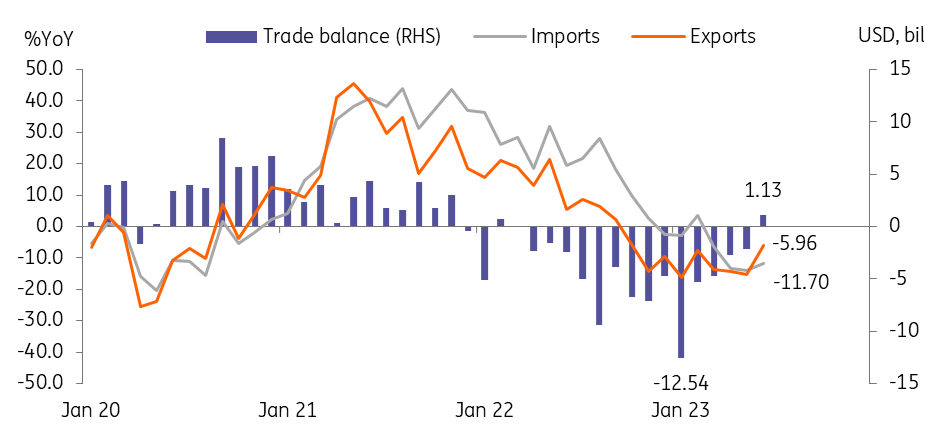June trade balance turns positive in Korea on strong transportation exports
Falling commodity prices are the main contributor to the improvement in the trade balance while the contraction in exports also eased gradually. Transportation exports – motors and vessels – are particularly strong while chip and petroleum exports continue to be a drag on the overall export performance
| -6.0% |
Exports%YoY |
| Lower than expected | |
Exports dropped -6.0% YoY in June (vs -15.2% in May, -3.6% market consensus)
Exports fell for the ninth month in June on the back of weak chip (-28%) and petroleum (-41%) exports. However, the decline in exports seems like it is bottoming out from the recent low of -16.4% in January, thanks to strong gains in vehicles (58.3%) and vessels (98.6%). In the second half of the year, we expect solid transportation exports to continue. For vehicles, there will be robust global demand for EVs and batteries. In the case of ship exports, ships ordered during the pandemic time are expected to be completed and delivered from this year. Meanwhile, chip exports are expected to remain sluggish at least until the next quarter, however, there is solid demand for high-end chips.
Despite expectations of only a modest recovery in exports, the trade balance is expected to remain in surplus from now on as the impact of import declines will accelerate with rapidly falling global commodity prices.
Korea posts the first trade surplus in sixteen months in June

Global demand conditions vary by region
By destination, exports to the US shed 1.8%, for the third monthly decline. We still see strong demand for vehicles with a 59.5% gain but semiconductors and petroleum exports are down by 64.1% and 35.1%, respectively, mainly due to unfavourable price effects. We cautiously predict a slowdown in demand from the US in the second half of the year. Meanwhile, Korean exporters benefitted from the strong infrastructure investment in the Middle East. Exports to the Middle East rose 14.0% with rising vehicles (28.1%), steels (160.0%), and machinery (57.9%) exports. In the second half of 2023, we think exports to developed markets are expected to turn weak but exports to the Middle East and Asia should improve.
Exports to the US shed for three months in a row

BoK watch
With better-than-expected industrial production data from yesterday, today's trade outcomes also support the view that second quarter GDP should accelerate from the first quarter. With the recovery continued, the Bank of Korea is likely to remain hawkish for the time being. However, we still think that additional hikes are not foreseable until the end of this year as inflation is expected to reach the 2% range soon and to stay there throughout this year.
This publication has been prepared by ING solely for information purposes irrespective of a particular user's means, financial situation or investment objectives. The information does not constitute investment recommendation, and nor is it investment, legal or tax advice or an offer or solicitation to purchase or sell any financial instrument. Read more
Download
Download snap